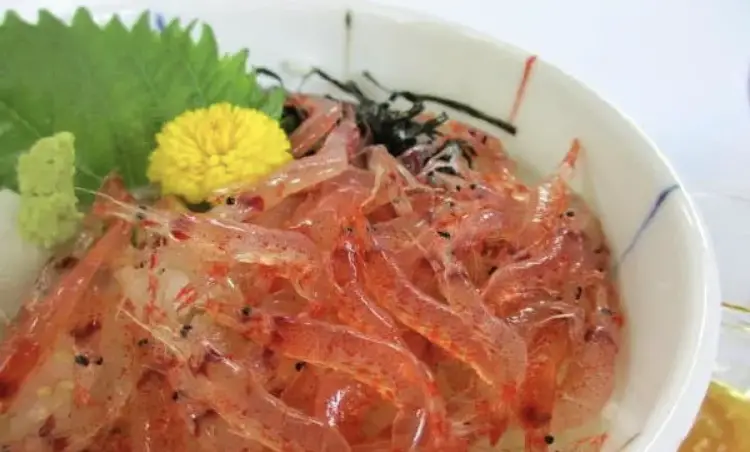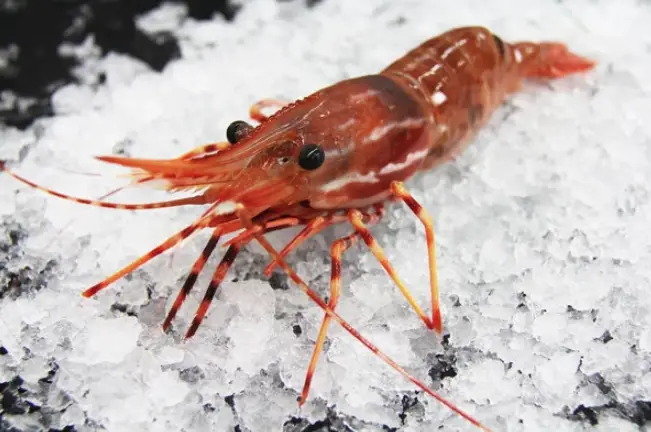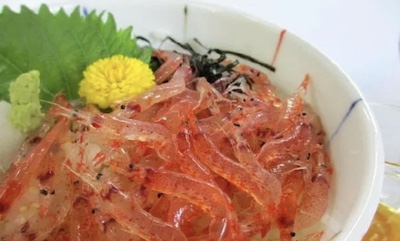We are reader supported. When you purchase through links on our site, we may earn an affiliate commission. Also, as an Amazon affiliate, we earn from qualifying purchases.

Raw fish is an integral part of sushi and when talking about it, most people will instantly vision a shiny and sleek fillet of orange salmon or red tuna over a bed of rice. However, sushi is not just limited to tuna and salmon. It encompasses a wide gamut of raw fish and seafood, some that you can’t even imagine.
A friend once asked me ‘can you eat raw shrimp in sushi?’ To that, I answered, why not? Raw shrimp tastes great and it is considered as an expensive delicacy. In some cultures, people relish eating the liquid inside the head, while there are regions where live shrimps are dipped in sauce and eaten raw.
Despite being a much sought after delicacy, people often consider it risky and unsafe to eat raw shrimps. There may be the risk of bacteria, virus, and parasites that may lead to food poisoning, but it all depends on the type of raw shrimp you eat and how it was handled after being caught.
As per the Academy of Nutrition and Dietetics, there’s a very minute risk involved with eating raw shrimp in case of healthy individuals. However, those who have a weakened immune system such as pregnant women, elderly, and small children may be at high risk.
Contents
Tips For Buying Raw Shrimp For Making Sushi
If you are a healthy individual, it is absolutely safe for you to eat raw shrimp but you must buy the right species that have been handled properly after being caught, store them well, and use good techniques for preparing sushi. Here are a few tips to help you make the right choices:
To make sushi at home, you need to buy only the highest-grade and freshest quality shrimp available in the market. Ideally, look for the shrimps that are still alive when you buy them.
Inspect the shell of the shrimp to ensure that they are shiny and translucent. If the color of the outer shell is off, the meat inside will also not be at its best.
Sniff the shrimps and use your sense of smell to ensure that the shrimps are the best quality. There should be no to very little odor.
If you are using frozen shrimps instead, always check the date when it was packaged and choose the one with package date close to the day of purchase.
Whether you buy alive or frozen shrimps, always buy from a trusted local fishmonger. When buying online, select a reliable source such as the Catalina Offshore Products.
Prepare the live shrimps for your sushi dinner as soon as you get home. If not ready to make dinner yet, store inside the refrigerator.
If you have bought frozen shrimps, store inside the freezer until you are ready to use them. There should not be any ice crystals inside the package. In case you see ice-crystals, don’t eat it raw, cook it instead. You can get ideas for cooking shrimps to use in sushi here – 7 Sushi Roll Recipes With Shrimp.
The Best Shrimps You Can Eat Raw
Now that you have got the answer to ‘can you eat raw shrimp in sushi’, it is important to know what type of shrimp can be best eaten raw. According to some raw seafood enthusiasts, sakura ebi and botan ebi taste great when eaten raw. Kuruma ebi may also be consumed raw but it lacks flavor.

In my opinion, the best shrimp to eat raw is ama ebi, also known as spot prawns. They are known for their characteristic sweet taste that comes out in full flavor when consumed raw and cooking can spoil the taste. The ama ebi have an interesting characteristic. They start out as males and turn into females in the second half of their lifetime as they mature.
Fresh or Frozen Shrimps: Which Is The Best?
If you love shrimps and buy them often, please be aware that the vast majority of the seafood you see at your local fish market or supermarket are deep-frozen once they are out of the sea. These frozen shrimps are delivered in that state when ordered online from reputed sites.
If you see ‘fresh shrimps’ displayed at the counter, they are probably thawed before being put on display. I would strongly recommend you to avoid buying shrimps labeled as fresh because there’s no way to find out how long they have been defrosted. They are definitely not meant for raw consumption.
The only situation when fresh shrimps are really fresh is when they are still alive. If you would like to eat raw shrimp sushi, look for live prawns at the local fish market. Those who live closer to the sea may be in luck to find live prawns on sale. Others may have to be content with the frozen packages.
Different Types Of Shrimps
When people think about shrimps, they usually envision white, brown, or pink colored seafood. Do you know that there are differences between them? The brown shrimps are from the Gulf of Mexico where they thrive in warm and shallow water. Although firm outside, they don’t have a strong flavor.
White shrimps are mostly found in Latin America and some parts of China and Thailand. These shrimps tend to be sweeter and tender. Their tail has a characteristic green hue. The pink shrimps are the most delicious types. They are mild and sweet, with delicate flavors.
Tiger Shrimps

Mostly found in Asia, these shrimps are large-sized and they are mostly farmed around the world. Whether you buy the fresh or farmed tiger prawns, they have a unique oceany flavor. You can find frozen tiger prawns in the frozen section of the Asian grocery store. I would not recommend eating them raw. The tiger shrimps should be properly cooked, grilled, or fried before being used in sushi.
Rock Shrimps
These are known as the deepwater inhabitants that thrive in the cold waters of Atlantic coast. They look very different from their warm water cousins as they boast a hard shell and segmented flesh that resembles a lobster’s tail. The rock shrimps are sold pre-peeled because it’s difficult to remove the shells without a machine. They are not meant to be eaten raw and should be properly cooked before consumption.
Spot Prawns

These are small-sized shrimps that are popularly known as ‘prawn’ in the English speaking countries such as Europe, Australia, and the UK. There is a misconception that prawns are larger than shrimps but this is not true. In reality, the choice of names is just a regional preference. Also known as ama ebi, the spot prawns are highly prized for their sweet taste and delicate flavors. They taste best when eaten raw and are one of the most popular varieties of raw shrimps used in sushi.
Steps To Prepare Raw Shrimps For Sushi
First, thaw the frozen shrimps by keeping them in the fridge overnight. If you need to thaw quickly, take them out in a bowl or put the entire packet in a bowl under cold running water.
Use a sharp Japanese knife to remove the head part and the outer shells. Keep the tail on if you like. Some people prefer to keep their heads and grill them to serve as a side dish with raw shrimp sushi.
Now, use the knife to make a small slit at the back of the shrimp and remove the vein. This dark thread-like thing is the digestive tract and must be removed because it contains, well, shrimp wastes!
Boil one cup of water in a saucepan on medium heat and in another bowl, take half cup of water and add the ice cubes to it.
When all shrimps are properly cleaned, dip them in the boiling water for 30 seconds. Strain out and transfer immediately to the cold ice water. After 30 seconds, take them out and pat dry in a paper towel.
Risks Associated With Eating Raw Shrimp
Most people eat raw shrimp without any health risks, but very few people have reported ill effects such as food poisoning. As per a report, one in every six residents in the US report food poisoning caused by consuming raw shrimp every year.
The symptoms such as diarrhea or little upset stomach may start from 4-48 hours of consuming infected raw shrimp. Some people with a compromised immune system may suffer from nausea and cramps. Other rare symptoms include double vision, headaches, and muscle weakness. If you experience any of these symptoms, consult your doctor immediately.
FDA says all seafood should be cooked properly to rule out the risk of any foodborne illness. Some species may contain bacteria and parasite but they can be killed by freezing method, similar to sushi-grade fish. So, if you choose to eat raw shrimp, buy the previously frozen type to stay safe.
Related Questions
How long can you store fresh shrimps?
They should be refrigerated immediately and consumed within four days or stored inside the freezer for up to 5 months. If you plan to eat raw shrimps, make sure they are frozen at a very low temperature after being caught from the ocean.
What is the right method to thaw frozen shrimp?
The best way to thaw frozen shrimp is to remove it from the package and keep inside the refrigerator overnight or at least 24 hours to minimize the risk of any harmful bacteria. If you are using live amaebi, make sure you don’t put them under tap water as the chlorine content of tap water can kill them.
See Also: Can You Freeze Sushi?
What does ama ebi taste like?
This type of shrimp has a sweet taste and very delicate flavors that can be best enjoyed raw. If you need to cook the shrimps, make sure you do so only for a few seconds because excess heat can deteriorate the flavors.
Are pre-peeled shrimps good?
The pre-peeled frozen shrimps can be found at any grocery store and they seem to be an easy option due to affordable price and less time needed for preparation. I suggest avoiding them because they are mostly over handled, which makes them unsuitable for several recipes.

